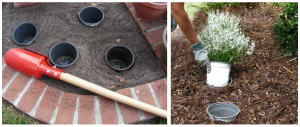Yes, even with cool weather setting in, much can be done on the flower gardening front. Let’s kickoff 2017 by being the envy of the neighborhood with flower beds that are rich and vibrant in color.

Credit: Sydney Park Brown, UF/IFAS.
Annual bedding plants are plentiful in variety and come in an array of colors and forms. These plants will highlight home landscapes, whether in beds or in containers on porches, decks and patios.
Annuals are divided into two categories, warm and cold season. Warm season are tender, and damaged by the first frost. Cool season on the other hand, cannot withstand heat or excessive rainfall. Therefore, to be successful with annuals, you must plant at the right time. For this region, late March for the earliest warm season annual planting and late fall for the earliest cool season annual planting is ideal. For the Panhandle, most annuals only live through the season, not the year. For this time of year, some examples of annuals that enjoy cooler temperatures are the pansy, viola, petunia and snapdragon.
When shopping for annuals, pay close attention to how much sunlight the variety will tolerate. This should be displayed on the container. Be sure to plant your annuals under a minimum of partial light. No annual can tolerate heavy shade. Remember when deciding on which variety to purchase, that annuals are an accent piece or supplement to the landscape, and not the focal point. Think of harmony and balance among other plants in your landscape before coming to a decision.

Credit: Sydney Park Brown, UF/IFAS.
As for care, be sure to water annuals after planting. Provide water on a routine basis until the root system has established. The best way to achieve this is making sure the topsoil layer stays moist early on.
Some gardeners prefer the “pot-in-pot” method with annuals. This method consists of sinking empty pots into the soil and then dropping potted annuals of the same size pot, into the empty pots. This works well for our area for two reasons. Often, our native soils, especially if you live closer to the coast, are not conducive to annual flower bed gardening. By using the pot-in-pot method, rich potted soil encompasses the annual throughout its life span and with no soil bed amendments needed. Also, this can make an otherwise long, laborious gardening day become very short regarding the change out planting from cold to warm season annuals and vice versa.
When supplying water to annuals, be careful with high pressure overhead watering systems, as this can damage petals and can cause bloom rot. A drip irrigation system or handheld hose watering is the best method. Fertilize annuals with a controlled release nitrogen fertilizer, so that a steady supply of nutrients is provided throughout the season. For weed control, mulching with use of pre-emergent herbicides is the best course of action. Depending on the size of landscape, hand weeding maybe the best practice. For pest management use a spot treatment insecticide for the entire flower bed once an insect infestation or disease problems emerge.
The information provided in this article will help your annual bedding plant efforts and in turn reward you with a beautiful flower landscape throughout the year. For more information on annual flower bedding plants, please contact your local county extension office.
Supporting information for this article can be found at the UF/IFAS EDIS Publication, “Gardening with Annuals in Florida” by Dr. Sydney Park Brown: http://edis.ifas.ufl.edu/mg319
UF/IFAS Extension, An Equal Opportunity Institution.
 0
0
